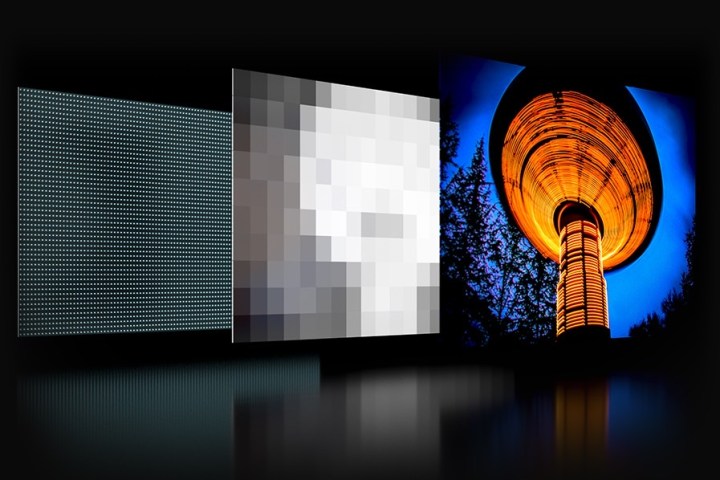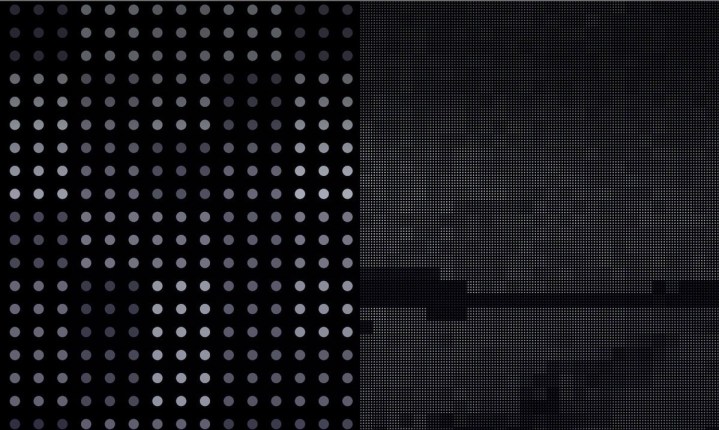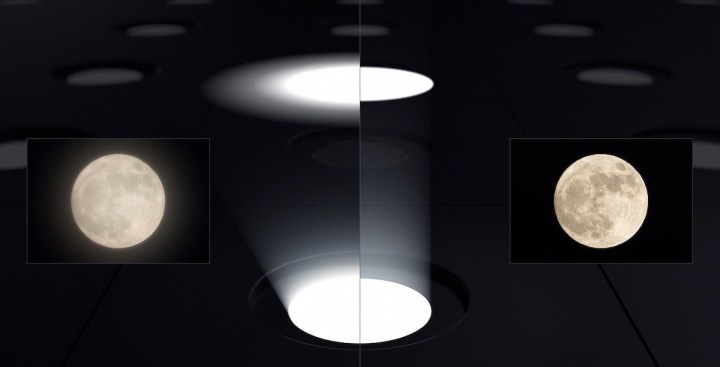

On the subject of televisions, OLED panels have turn out to be extremely fascinating due to their very good image high quality. OLED achieves its image efficiency partially because of one key attribute: It has individually illuminated pixels. When an OLED pixel is turned off, it’s utterly black, which supplies OLED TVs their much-vaunted “infinite distinction.”
And since the human eye is extremely delicate to distinction, we’ve a powerful choice for the way motion pictures and TV reveals (and even nonetheless images) look on an OLED TV.
Conventional flat-screen TVs with LCD panels and LED backlights battle to compete relating to distinction. They’ll actually (ahem) outshine OLED relating to brightness, however they’ll’t management that brightness at a pixel degree like OLED, so it’s unimaginable for them to realize OLED’s excellent black.
However simply when it appeared that OLED possessed an insurmountable benefit, LED TV makers introduced that that they had discovered a know-how that had the potential to degree the enjoying subject with OLED: mini-LED.
What’s a mini-LED TV?

Mini-LED TVs are basically the identical as normal LED TVs, besides that the place LED TVs generally dissipate to some hundred particular person LEDs of their backlights, mini-LED TVs use hundreds of a lot smaller LEDs in the identical area.
Do mini-LEDs use quantum dots?
Usually talking, sure. Up to now, we’ve by no means seen a mini-LED TV that wasn’t a quantum-dot TV (QLED TV). Nevertheless, this isn’t a tough and quick rule. There’s no motive why a non-quantum dot TV couldn’t use mini-LEDs in its backlight, however since mini-LEDs are nonetheless comparatively new and are sometimes getting used on mid-to-high-end fashions, quantum dots may be thought-about an anticipated characteristic of mini-LED TVs.
Why the dimensions (and amount) of LEDs issues

For LED TVs, image brightness is managed by a backlight. The backlight is made up of particular person LEDs. In lower-cost LED TVs, each LED within the backlight is managed collectively — all of them get brighter or dimmer concurrently. The difficulty is, most on-screen photos are made up of vivid and darkish areas, so if you need a vivid area to be actually vivid, and your backlight basically behaves as a single LED, it’s worthwhile to use the LCD panel to dam the sunshine at midnight components of the picture. This yields blacks which might be typically no darker than gray.
Nevertheless, extra superior LED TVs group their particular person LEDs into zones, and every zone can then be dimmed independently. For those who’ve ever seen the time period full-array native dimming (or FALD), that’s what it’s referring to.
FALD backlight zones may be synchronized with vivid and darkish areas of the image. This drastically reduces the TV’s reliance on its LCD panel to dam mild — as an alternative, it merely dims the suitable zone.
With regular-sized LEDs, there’s a sensible restrict to what number of zones you may have, particularly on smaller display screen sizes the place the ratio of display screen dimension to LED dimension forces firms to make use of fewer LEDs. Mini-LEDs — even when they produce the identical degree of brightness as common LEDs — are far smaller. Extra of them may be packed into the identical area, which opens up the potential for extra zones and extra even mild distribution inside a zone.
Why mini-LED may imply a giant enhance for image high quality

In an ideal world, mini-LEDs would shrink to the dimensions of a pixel, and every of those mini-LEDs can be handled as its personal zone, getting brighter and dimmer independently of its neighbors, with no mild bleed from one mini-LED into its neighbor’s area. Such a system would successfully match OLED’s distinction completely (or at the very least compete way more intently), whereas additionally offering better brightness and eliminating the danger of burn-in. That’s just about what a MicroLED TV does, however that know-how continues to be prohibitively costly.
Nevertheless, LED TVs don’t want to realize pixel-level brightness management as a way to produce a picture that — to most people — can rival OLED. We don’t have an actual ratio, however a mini-LED TV with a backlight divided into hundreds of zones would possible have sufficient flexibility over regional display screen brightness to create a really convincing various to OLED.
Why not all mini-LED TVs will ship higher image high quality

If mini-LED TVs deal with the distinction challenge so successfully, ought to we assume a mini-LED TV shall be simply pretty much as good as OLED? No.
Mini-LEDs are probably in a position to assist LED TVs overcome one of many largest obstacles (managing brightness and distinction at a granular degree) to rivaling OLED, however lots of different issues must be completed proper as a way to notice this potential.
Mini-LEDs on their very own don’t supply a lot of an enchancment over common LEDs if there aren’t a enough variety of them. Whatever the variety of particular person mini-LEDs, in the event that they haven’t been subdivided into sufficient zones, the TV received’t be capable to make the most of them.
Lastly, and that is arguably a very powerful half, the TV wants processing energy and top-notch algorithms as a way to management these zones with velocity and accuracy. 5 hundred zones received’t assist with image high quality if the TV is struggling to synchronize them with fast-moving imagery.
Very like a Components 1 crew will solely succeed if the engine, the suspension, the motive force, and their pit crew are all working in excellent concord, a mini-LED TV can solely succeed if its parts are organized and managed appropriately.
Who makes mini-LED TVs?

Most main TV manufacturers now make mini-LED TVs, although some firms select to make use of their very own title for the know-how. TCL, one of many first firms to make use of mini-LED backlights, calls it out, generally proper within the TV’s mannequin title, a observe that Sony has began to do too. Samsung calls its mini-LED fashions “Neo QLED,” whereas LG prefers the “QNED” moniker — although that one is a bit tough as not each LG QNED TV makes use of mini-LEDs. Hisense has been probably the most aggressive adopter of mini-LED know-how — all of its present ULED 4K fashions at the moment are mini-LED geared up.
Are mini-LED TVs costly?
No, in actual fact, some mini-LED TVs are priced on par with normal QLED TVs. The entry-level 65-inch Hisense U6, for example, is usually $800 and may typically be discovered discounted to a a lot cheaper price.
That mentioned, mini-LED TVs may be simply as costly as (or greater than) their OLED counterparts. Samsung’s mini-LED-powered 65-inch 4K QN90C prices $2,800 — whereas its OLED-powered 65-inch 4K S90C is $2,600.
Ought to I purchase a mini-LED TV?
Sure, however you shouldn’t purchase one simply because it makes use of mini-LEDs. As we mentioned above, a mini-LED is only a very small LED mild. Having a backlight fabricated from mini-LEDs is simply the place to begin. In some circumstances, a mini-LED TV could not supply any benefits at throughout an everyday LED TV, and you could find yourself spending greater than it’s worthwhile to.
As at all times, our recommendation is to do your homework. Learn in-depth TV evaluations before you purchase and take cautious notice when the reviewer discusses these important areas round brightness and distinction — if these aren’t noteworthy, it may very well be a sign that the producer has didn’t take full benefit of its mini-LED potential.
Editors’ Suggestions